Santa Barbara City Hall to Conduct ‘Living Experiment’ on State Street Promenade
With Bright-Green Bike Lanes Gone, City to ‘See What Stuff Works’ to Keep Pedestrians and Cyclists Safe
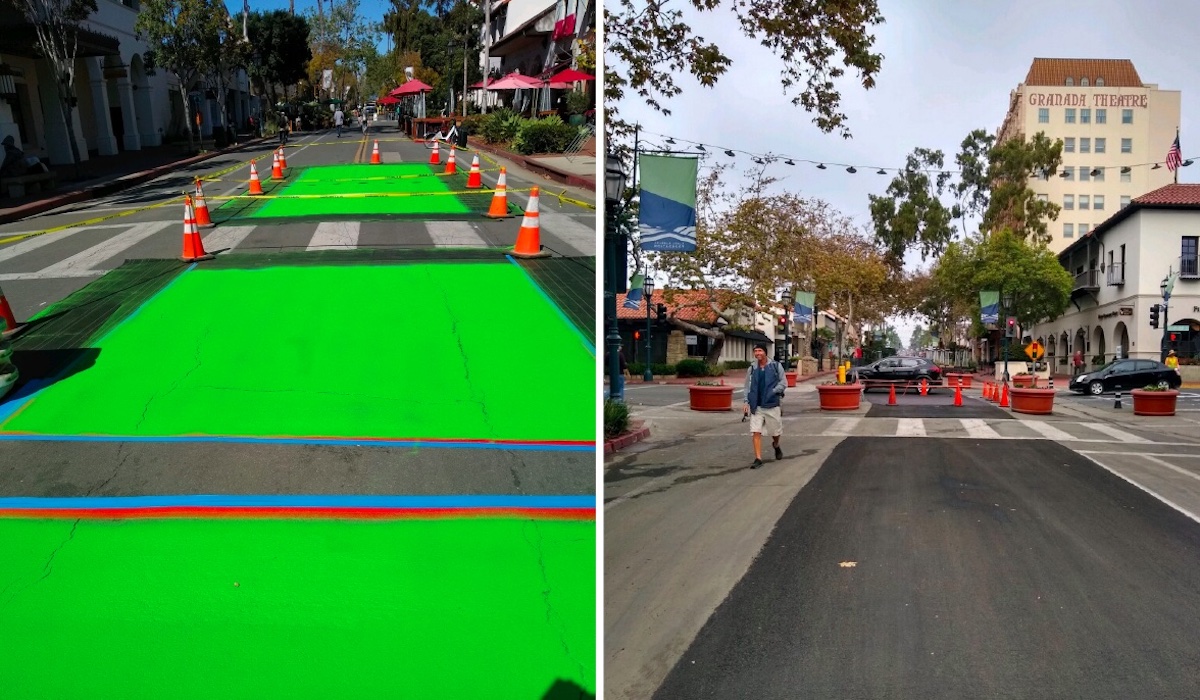
At a time when many Santa Barbara city streets have become perpetual construction projects — much to the chagrin and exasperation of motorists hoping to get from Point A to B — work crews wearing lemon-yellow construction vests have been dispatched by City Hall to an eight-block downtown stretch of State Street to remove any trace of the luminescent bright-green street paint designed to guide cyclists into the center of the street. In place of the bright green — likened unfavorably to the color of miniature golf courses when first installed a year and a half ago — street crews have been busy scraping off the epidermis of paint from both sides of the affected intersections, raking the pavement, and then installing large rectangles of intensely aromatic, freshly cooked slurry seal. In other words, it’s been the equivalent of massive skin graft surgery on the intersections from Victoria to Cota streets — an operation, it was revealed this Friday, meant to clear the way for a “living experiment” to find a better way for cyclists and pedestrians to safely coexists on the State Street Promenade.
The timing, suddenness, and intrusiveness of this endeavor has left many passersby scratching their heads and has sparked a considerable amount of speculation and suspicion, particularly among bicycle riders and their advocates — for whom the green paint was installed following the creation of the State Street Promenade in the midst of the COVID pandemic.
“There are some people who think this is part of a broader conspiracy hatched by Mayor Randy Rowse to bring cars back to State Street,” Councilmember Michael Jordan said. “That’s 100 percent and unequivocally false.” (Mayor Rowse has been known to harbor some interest in returning cars to a few of the blocks of the promenade, an experiment in urban engineering to which he has been famously lukewarm.)
Jordan is one of three councilmembers who sits on an ad hoc subcommittee (the name of which even he can’t quite get straight) designed to address the interim needs of State Street and the promenade until a long-term master plan is finally hashed out several years from now. The other two councilmembers on the ad hoc interim committee, as it’s known, are Kristen Sneddon and Oscar Gutierrez. They meet behind closed doors where the public is not allowed to attend with no agendas prepared in advance nor minutes provided after the fact. By law, all the usual open-government rules do not apply to ad hoc committees, which may account for their growing popularity.
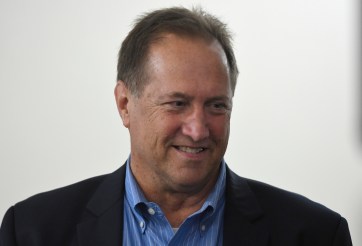
Jordan said the green paint that was surgically splashed at promenade intersections has been “marginally successful” at herding bike riders on State Street into the middle of the street. It has been an utter failure, however, directing pedestrians, he said. Given the large number of pedestrians and bicyclists now sharing State Street’s new car-free environment, Jordan said, serious safety concerns must be addressed. Adding urgency to this equation has been the recent surge in the popularity of electric bikes, many of which can achieve top speeds of 28 miles per hour.
“Nobody’s figured this one out,” Jordan said. “There are no obvious solutions. But it has to be done. We’re getting bombarded with complaints. Someone could get hurt.”
Beginning early in November, he said, City Hall will begin treating the State Street Promenade as a giant “living experiment” where different approaches to solving the problem will be tried out in real time based on the number and proximity of parklets and pedestrians. In the meantime, he said, city police will begin enforcing the vehicle code — or some variant thereof — to make sure cyclists don’t run red lights and stop signs with impunity and pedestrians are not in jeopardy.
To the extent reliable statistics exist about the number of accidents and collisions involving cyclists and pedestrians on the promenade, Jordan makes no pretense of knowing them. As a matter of political reality — impressionistic and anecdotal as that may be — the level of concern, hostility, and outright anger directed at youthful e-bike riders has become nothing short of intense.
Sign up for Indy Today to receive fresh news from Independent.com, in your inbox, every morning.
At a meeting of the ad hoc interim committee that took place on Friday morning, Jordan said city staff revealed that during the summer, the promenade would get 7,000 visitors a day on weekdays and 12,000 visitors a day on weekends. The number of bike riders tabulated in that time on weekdays was 2,000, and 2,400 on weekends. Of those bikes, 20 percent were clocked going faster than 15 mph. Two percent were clocked travelling at 20 mph or faster.
Aside from police officers not wanting to enforce in this sort of alt transit rodeo, it turns out, they might lack the legal tools. Once vehicles were banned from State Street, Jordan noted, questions surfaced as to how legally applicable the Vehicle Code was. He said that the City Attorney’s Office would be hashing that out with city police to create an enforceable template of rules for the promenade’s new road.
Jordan acknowledged he’s heard many complaints that the city’s usual public process has been bypassed. He indicated that the “living experiment” model proposed by Brian Bosse, now running the downtown parking department, needed to be quick and nimble, and that the city’s traditional process was too cumbersome. (Bosse, in a previous incarnation, was the staff person charged with citing, permitting, and developing the first — and only — public restrooms on State Street.)
“We need staff to be proactive, imaginative, innovative, experimental, and practical,” Jordan stated.
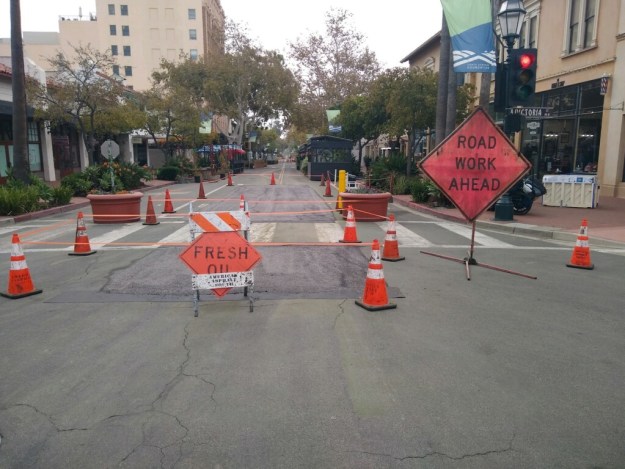
That approach has its critics among many of the traditional stakeholders in the city’s process. Many prominent members of various advisory committees have expressed frustration that they were kept in the dark about the changes of plans until the last minute. But to an exceptional degree, for the past two years, City Hall has been reinventing State Street pretty much on the fly. Ironically, it was only after Jordan and Councilmember Sneddon threatened to take the matter to the council as a whole that City Administrator Rebecca Bjork and Bosse got serious about making changes. Some of those changes, Jordan said, he could talk about. Many, he said, he could not. At least not yet.
For much of many parts of the promenade, he said, it’s likely that there will be two bike lanes down the center of the street, one headed up the street and the other down. Pedestrians would gravitate to the side. But in other parts of State Street — where there are few if any parklets — there will be more focus on activating the dead spaces with street furniture, kids play equipment, basketball hoops, or perhaps live music. On those blocks — the 700, 800, and 900 blocks — the bike lanes would be set more to the side of the street with the most active retail areas. Different sorts of barricades will be tried out at different stretches of the street to force cyclists to dismount and walk from block to block.
“What we want to do,” Jordan said, “is see what stuff works. And what doesn’t.”
But bikes, he stressed, aren’t going anywhere.
Support the Santa Barbara Independent through a long-term or a single contribution.

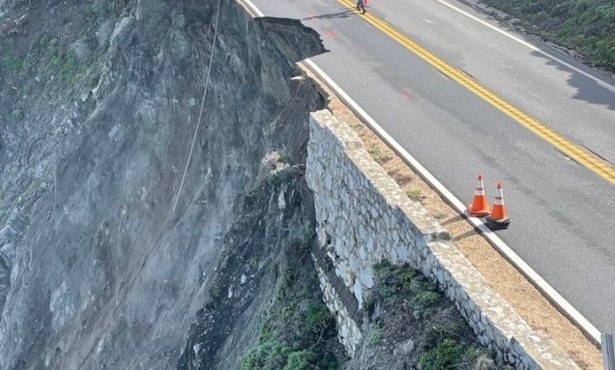
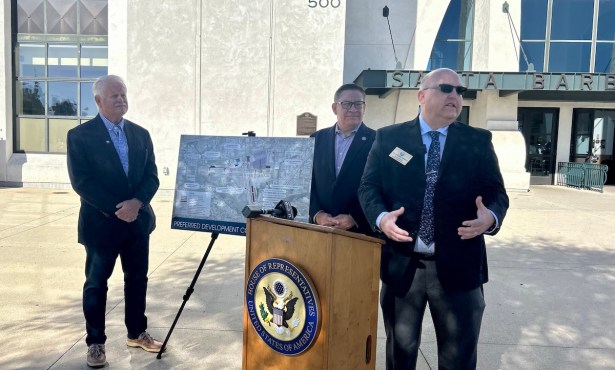
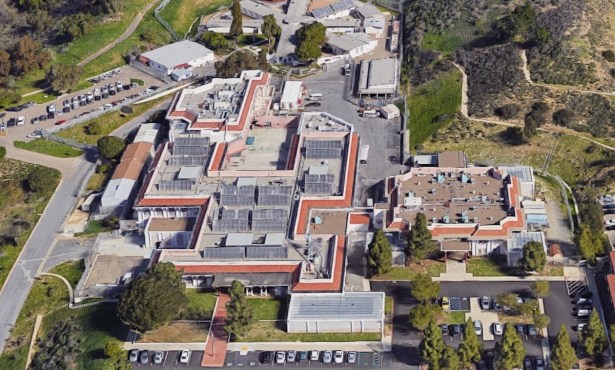
You must be logged in to post a comment.